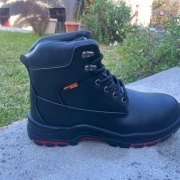Stainless Steel Midsoles Verses Anti Puncture Material (Kevlar) Midsoles
Choosing between a stainless steel midsole and an anti-puncture material midsole can be a crucial decision when it comes to selecting the right safety boots for your specific needs. Both options offer unique benefits and advantages, but understanding the differences between them is essential for making an informed decision. In this blog post, we will explore the advantages and disadvantages of stainless steel midsoles and anti-puncture material midsoles to help you determine which option is better suited for your safety footwear requirements.
Stainless steel midsoles have been a traditional choice in safety boots for many years, offering excellent puncture resistance and protection against sharp objects. The stainless steel material is extremely durable and provides maximum strength and stability, making it an ideal choice for environments where the risk of puncture injuries is high. Stainless steel midsoles are also highly effective in protecting the foot from sharp nails, glass shards, and other hazardous objects that may be present in industrial and construction settings.
One of the key advantages of stainless steel midsoles is their reliable puncture resistance, which is achieved through the dense and rigid nature of the material. Stainless steel is capable of withstanding high levels of pressure and force, making it an effective barrier against puncture injuries. This level of protection is particularly important for workers who are exposed to sharp objects or debris on a regular basis, as it helps to prevent serious foot injuries in hazardous environments.
In addition to their puncture resistance, stainless steel midsoles also offer excellent durability and longevity. They are highly resistant to wear and tear, maintaining their protective qualities over an extended period of time. This makes stainless steel midsoles a cost-effective investment for workers who require durable and reliable safety footwear for daily use in challenging conditions.
However, there are some drawbacks to stainless steel midsoles that should be considered when selecting safety boots. One of the main disadvantages is the weight of the material, which can make the boots heavy and cumbersome to wear for long periods of time. Stainless steel midsoles are also rigid and inflexible, which may limit the overall comfort and flexibility of the footwear, especially for workers who are required to be on their feet for extended periods.

The ProFit Tarantula safety boot with kevlar midsole
On the other hand, anti-puncture material midsoles offer a lightweight and flexible alternative to stainless steel midsoles, providing similar levels of puncture resistance without the drawbacks of weight and rigidity. These midsoles are typically made from advanced materials such as Kevlar, composite fibers, or high-density textiles, which are designed to be strong, lightweight, and flexible while still offering excellent puncture protection.
One of the key advantages of anti-puncture material midsoles is their lightweight construction, which allows for greater comfort and agility when wearing safety boots. Workers can move more freely and comfortably in boots with anti-puncture midsoles, reducing fatigue and discomfort during long hours on the job. The flexibility of these materials also enhances the overall fit and comfort of the footwear, allowing for a more natural range of motion.
Another benefit of anti-puncture material midsoles is their thermal insulation properties, which help to keep the feet warm and comfortable in cold environments. These materials are also non-metallic, making them ideal for workers who are exposed to metal detectors or sensitive electronic equipment. Anti-puncture midsoles are a versatile and practical choice for a wide range of industries and applications, providing reliable puncture protection without the drawbacks of weight and rigidity.
However, it is important to note that anti-puncture material midsoles may not offer the same level of puncture resistance as stainless steel midsoles in certain extreme conditions. While they are designed to provide protection against sharp objects and debris, there may be instances where stainless steel midsoles offer superior puncture resistance and durability. Workers should assess the specific risks and requirements of their work environment to determine which type of midsole is best suited for their needs.
In conclusion, the choice between a stainless steel midsole and an anti-puncture material midsole ultimately depends on the specific requirements and preferences of the individual wearer. Both options offer valuable benefits and protection against puncture injuries, but each has its own set of advantages and disadvantages that should be carefully considered. By weighing the factors of puncture resistance, weight, flexibility, durability, and comfort, workers can make an informed decision on which type of midsole is better suited for their safety footwear needs. Ultimately, the most important factor is to ensure that the safety boots provide adequate protection and comfort for the wearer in their particular work environment.
For a chat about your work forces safety boot requirements please give us a call on +27 11 892 8030 / 8031 / 8032 or drop an email to organise a call info@profitfootwear.co.za


